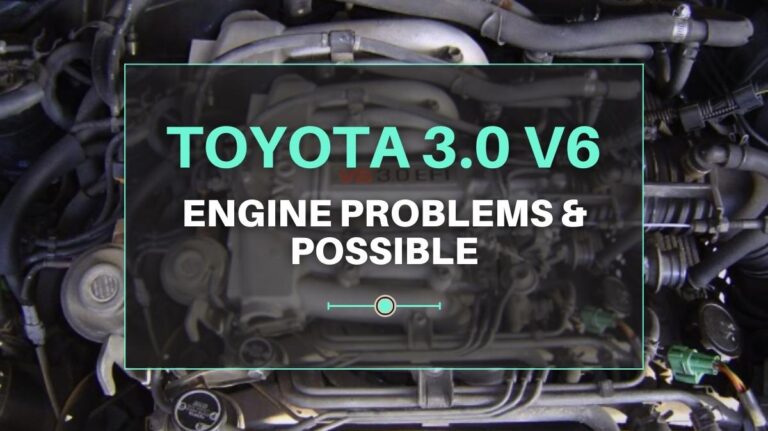Apart from Toyota 3.0 v6 Engine Problems that sometimes create discomfort, the engine is powerful compared to other brands.
Toyota is a brand that has been established in the market for decades.
Parts produced by this company are often the best compared to the rest, which is why many car owners expect nothing but excellence.
However, the Toyota 3.0 v6 engine has always been controversial — Sort of like the black sheep in an otherwise perfect manufacturer.
This engine can have many issues when least expected, such as overheating, blown head gaskets, and more.
Since leaving those issues unattended could lead to accidents, today we’ll learn about the Toyota 3.0 v6 engine problems and possible solutions.
Without anything else to add, let’s begin by talking about the engine itself.
Check out the best seat covers for Toyota Prius here!
What is the Toyota 3.0 v6 engine?
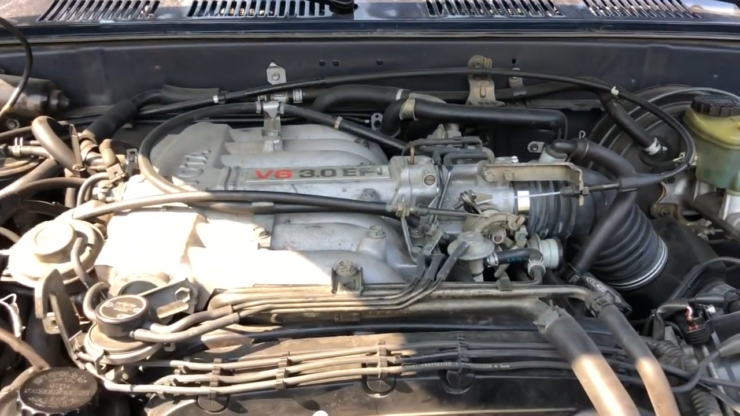
Produced near the 90s, the Toyota 3.0 v6 engine was released as part of the Toyota 4Runner. It would then get installed in other off-road Toyota cars as time went by.
Compared to its predecessors, it’s clear that the 3.0 6V and the 2VZ engine share plenty of similarities with slight variations.
For instance, though they both have a similar cast iron cylinder block, the 3.0 v6 cylinder block is 20mm taller.
As mentioned before, the engine has a similar cast iron cylinder block, and only these are a bit taller.
Plus, inside the block, the engine has an improved crankshaft featuring nine counterweights and an 82mm stroke.
This engine has plenty of optimized features that separate it from previous models; Toyota improved the intake valves’ shape, the exhaust valves were redesigned, and no hydraulic filters were involved.
Also, there are different values for the adjusting valve gaps like 0.25-0.35mm intake and 0.15-0.25mm exhaust.
Despite some issues that we’ll talk about in a bit, this engine still delivers reliable performance, as we’d expect from Toyota.
Features of Toyota 3.0 V6 engine
After learning a bit more about the engine, let’s briefly talk about some of its features. Then, we’ll head deep into the different issues the engine faces.
- Cylinder Build: Cast-iron
- Weight: 420 to 440 pounds
- Engine Displacement: 2950 to 3000 cc
- Maximum Horsepower: 140 to 150 BHP
- Maximum Torque: 200 to 240 Nm
- Number of Valves: 12 Valves
- Drivetrain: AWD
- Number of Speeds: 5 Speeds
Cylinder Build
The engine features aluminum for the cylinder head and cast iron for the cylinder block.
Regardless of whatever issues these components may cause in the future, they still put up a solid performance for thousands of miles.
Weight
At 439 pounds, the engine is a bit heavier than most. It secures a firm installation on the vehicle, meaning that it’d hardly gives any issues due to unexpected movements.
Applications
Due to its design, which requires a 15-degree angle for installation, the engine can fit many applications.
The engine is suitable for some of the most popular Toyota car models.
Some of them are the Toyota 4Runner, Camry, Hilux, T100, and the Lexus ES300 or Toyota Windom.
Learn about the best floor mats in the market for Toyota Sienna here!
The Common Toyota 3.0 v6 Engine Problems
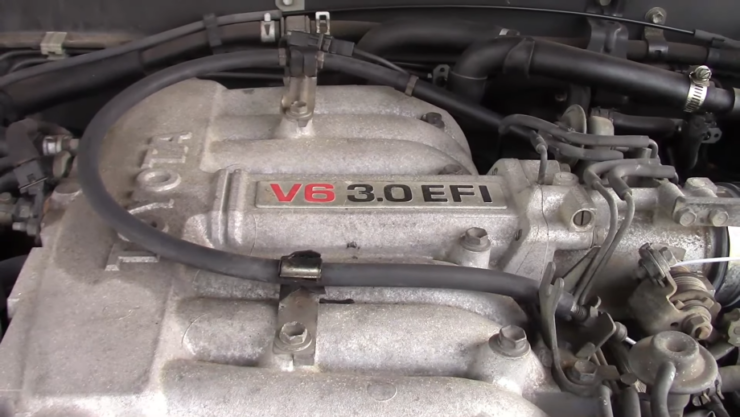
There’s no denying that this engine is among the best out there. However, there are several Toyota 3.0 motor problems that may pop up eventually.
Though some of these issues are almost inevitable, knowing how to spot them and being fully prepared will allow car owners to fix them quickly.
Overheating Problem
Overheating is a common issue that owners face with this engine. Though the reasons are many, the common cause behind this problem is a malfunctioning thermostat.
Thermostats keep the coolant from getting inside the engine until it warms up, which allows it to get to the operating temperature more quickly. When it fails, the coolant doesn’t flow properly.
Oil Leaking Problem
When there are oil leaks and no clear sign of why the issue is happening, the camshaft seals are an excellent place to start inspecting.
Typically located above the cylinder head — right towards the engine’s rear and close to the firewall — the camshaft seals leave oil traces on the engine’s rear under the valve cover.
Blowing Head Gasket Problem
Responsible for sealing the internal combustion process, the head gasket is an essential part of the motor. Sadly, they’re not perfect. Head gaskets may blow up for many reasons, resulting in the car making strange noises or behaving oddly.
While detecting blown head gaskets is tricky, a common symptom is leaking in the cooling system.
Knock Sensor Problems
Though it’s a rare occurrence, knock sensors do fail from time to time. Luckily, knowing there’s a problem with this component isn’t hard, as it comes in the form of the dreaded code 52.
This error is visible via the check engine light, which allows mechanics to figure it out quickly.
Coolant Fan Problem
Coolant fans have plenty of electrical components behind them that keep them running. One of those is the motor, which naturally ages as time passes and could lead to malfunctioning circuitry.
When this happens, the fan may not operate properly — Or it could simply stop working entirely.
Radiator Defect
Over time, radiators may face damage or clog issues. These issues primarily occur because of contaminated coolant or extreme debris buildup, leading to many more problems down the road.
If the vehicle has plenty of miles, checking the radiator to prevent these problems would be a good idea.
Rod Bearing Wear Problem
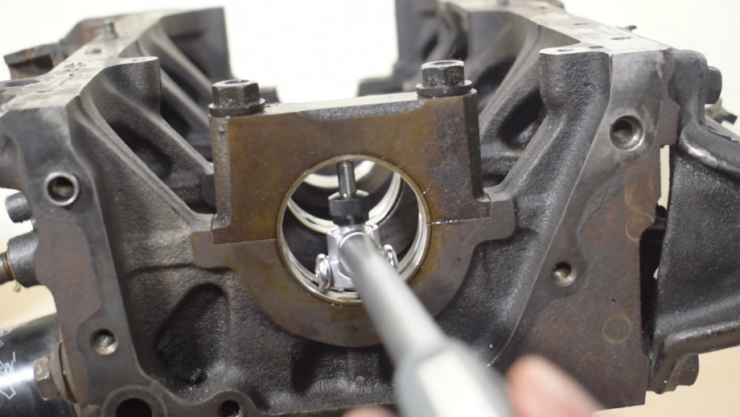
Been noticing engine noise or oil pressure loss? The common reason behind those issues is a worn-out rod bearing.
Luckily, figuring out this issue doesn’t take much time due to the symptoms mentioned above. You can act quickly to fix the problem and avoid further inconveniences while driving the vehicle.
Cylinder Head Crack Problem
The cylinder head handles the internal combustion in the engine’s cylinders, which means that car owners will notice a sudden decrease in the engine’s power and efficiency if it doesn’t work correctly.
Cylinder head cracks then lead to lower gas mileage, poor acceleration, and other problems.
Want to know all about the smart key of your Toyota? Click here!
Possible Solutions of Toyota 3.0 v6 Engine Problems
While the issues mentioned above can be frustrating, they’re not impossible to solve. Below, you’ll find a solution for each and how much it may cost:
Overheating Solution
Replacing a thermostat is a common issue most car owners will have to face eventually, regardless of both engine and car models.
The average cost to replace a thermostat is between $190 and $220, with labor costing around $115-145 and parts available between $75-$85.
The process itself is also pretty easy. Check out this video to find out more.
Oil Leakage Solution
The easiest way to fix the oil leak is by using products like the BlueDevil Oil Stop Leak. These substances can seal leaks permanently without damaging the engine’s structure.
Besides sealing leaks, these products can also repair rubber seals efficiently.
If the damage is too severe for that, replacing the camshaft’s components may be the next viable solution.
Cost for oil additives: $20 up. Replacement of the camshaft seal goes from $363 to $457.
Would you please take a look at this video to learn more about it?
Check out the best aftermarket CV axles here!
Blowing Head Gasket Solution
The cost of replacing a blown head gasket depends on aspects like the vehicle model, age, and damage to the head gasket.
After considering all of that information, you’d most likely face two costs: one to fix the problem, and the second would be to replace it.
In general, the average price of head gasket replacement varies between $1,400 and $2,500.
Learn more about it here.
Knock Sensor Solution
Start by locating the knock sensor on the vehicle, which usually sits at the engine’s front side. Continue by unplugging the wiring harness connector out of the knock sensor.
Then, use a wrench to access the hexagon-shaped part of the sensor. Proceed by turning the knock sensor counterclockwise to get it off the block and remove it.
Grab the new sensor, and smear dielectric grease over its threads. Use your hands to screw the sensor in. Follow up with a wrench to tighten it. Attach the wiring harness connector once again.
Estimated costs: $280-$350 for a new knock sensor and $220-$280 for labor.
Coolant Fan Solution
Before trying anything else, you should start by checking whether or not the motor is properly working. If that’s the case, then the solution is simple: replace the motor.
That’s about $590 and $624. If the engine doesn’t come on, then it means it isn’t getting enough power. The next step would be to check the fuse and the cooling fan temperature switch.
Here’s a video with precise, straightforward information on this issue.
Use the best rock sliders for your Tacoma; click here!
Radiator Solution
The replacement cost of a damaged beyond-repair radiator goes from $250 to $1,200. These costs include the parts needed for the repair as well as the installation.
To replace the radiator, the average cost is around $650. Of course, all of these prices may vary depending on the car model and how much work is necessary.
Rod Bearing Wear Solution
There’s a lot of ground to cover if we want to repair rod bearings.
Besides new connecting rods, the engine may also need pistons, camshaft bearings, and other components like timing chains and a crankshaft. In many cases, it’d be better to replace the complete assembly of the engine. Repairing rod bearings could go from $2,500 and more.
Cylinder Head Crack Solution
While fixing a cracked cylinder head is a bit tricky, there are two ways you can approach the situation.
First, you could try using Stop Leak or K-Seal, but only if the damage isn’t so bad that it requires a new cylinder head instead.
When the damage is bad, taking the vehicle to an expert would be the next thing. The repair bill may vary from $500 to $700.
Idle Issues Solution
Lastly, another problem with the engine is the idle issue. This could be caused by the idle air valve, which malfunctions.
To fix it, try putting aluminum tape over the idle air valve intake hole. Adding tape may be dangerous because it may get sucked into the engine, so use thin tape.
Alternatively, clean the auxiliary air valve. If that doesn’t work, then you’d have to replace the entire throttle body to get rid of the Toyota 3.0 v6 idle issues finally.
Pros & Cons of Toyota 3.0 v6 Engine
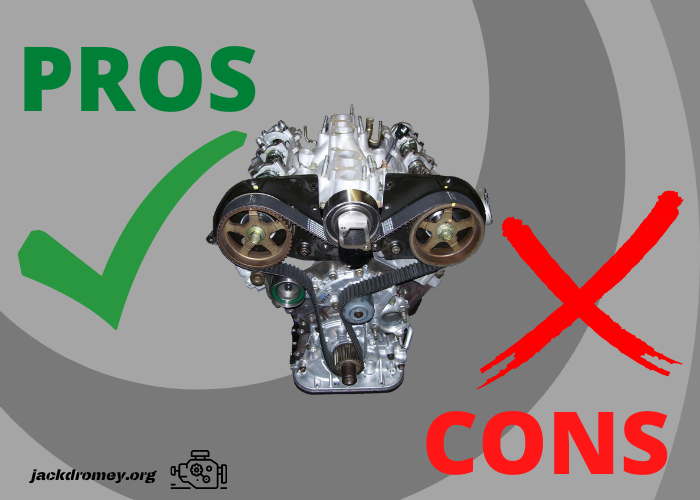
After going over our Toyota 3.0 V6 engine problems and possible solutions sections, you may be wondering: is everything about this engine just bad? Not entirely.
Our main topics in this article are its issues, but there are a few reasons why the 3.0 V6 is also good. Here’s why that is.
Pros
- An OK Engine
While this engine is far from the best, it’s still reliable. As long as it receives proper maintenance, it should perform alright.
- Consistent Speed
The engine manages to put out consistent speed power to keep the vehicle up and running regardless of the environmental conditions.
- Flexibility
Speaking of environmental conditions, the engine is perfect for off-road activities. Over tough surfaces, it provides the power needed to pull through safely.
Cons
- Many Issues
We wouldn’t be here on this topic if it weren’t because we’re talking about one of the biggest cons of this engine: the many issues it has.
This engine can go from a reliable part to frustrating by overheating, blowing head gaskets, and damaging radiators.
- Heavy
Earlier, I mentioned the weight of the engine as one of its most prominent features.
While it does have its benefits, working with it could be troublesome due to its weight, which can often feel too heavy for comfort.
Learn everything about connecting your phone to Toyota Bluetooth here!
FAQs

Still, confused about a thing or two regarding Toyota 3.0 v6 engines? Don’t worry. We may relieve that confusion below:
What vehicles used the Toyota 3.0 V6 engine?
The Toyota 3.0 V6 engine, also known as the 3VZ-FE engine, was used in several Toyota vehicles from the late 1980s to the late 1990s. Some of the most notable vehicles that used this engine include:
- Toyota Camry (1988-1991)
- Toyota Camry (1992-1996)
- Toyota Camry Solara (1999-2001)
- Toyota Avalon (1995-1999)
- Toyota Sienna (1998-2000)
- Toyota 4Runner (1988-1995)
- Toyota T100 (1993-1998)
The Toyota 3.0 V6 engine was also used in some Lexus vehicles, including the Lexus ES 300 (1992-1996) and the Lexus RX 300 (1999-2003). Overall, the Toyota 3.0 V6 engine was a popular and reliable engine that was used in many Toyota vehicles during its production period.
Is the Toyota 3.0 V6 any good?
For sure! Yes, the engine may have some issues sporadically, but most engines may have them as well.
While it’s true that the Toyota 3.0 v6 engine head gasket problems were frustrating, Toyota made it its job to recall most of the faulty parts released to the public.
Plus, with the many tutorials, DIY guides, and videos online, most car owners can fix most of the issues by themselves.
What’s the engine life of the Toyota 3.0 V6?
Generally, the engine will last anywhere from 200.000 to 300.000 miles before dying.
When the engine reaches the end of its life, you may start noticing increased oil consumption and knocking noises produced near the cylinder block area.
Once these problems start to show, it means that the engine is facing severe issues.
How to prevent Toyota 3.0 v6 engine problems?
Regular maintenance would be an excellent way to reduce the risks of having many engine problems, as it’d help you keep most parts of the engine working as they should.
However, other issues like a damaged thermostat are almost inevitable. In those cases, all you get to do is replace the parts.
Should I fix a Toyota 3.0 V6 engine or buy a new vehicle?
Whether to fix a Toyota 3.0 V6 engine or buy a new vehicle depends on several factors, including the age and condition of the vehicle, the cost of repairs, and the overall value of the car.
If the vehicle is relatively new and in good overall condition, it may be worth fixing the engine if the cost of repairs is reasonable and the vehicle is otherwise reliable.
However, if the vehicle is older and has significant wear and tear, it may not be cost-effective to repair the engine and may be more practical to consider buying a new vehicle.
Other factors to consider when deciding whether to fix the engine or buy a new vehicle include the resale value of the car, the availability of replacement parts and qualified mechanics, and the potential long-term maintenance costs.
It is also important to consider any other issues or problems with the vehicle that may need to be addressed in the near future.
Verdict
We’ve covered the main Toyota 3.0 V6 engine problems and possible solutions to be ready for anything that may come along the road.
Once you’re aware of how to diagnose these problems and what’s needed to fix them, the engine will have a healthy lifespan for many more thousands of miles.
Related Posts:
- Toyota 3.3 Engine Problems and Possible Easy…
- Toyota 2.4 Engine Problems & Easy Solutions - Keep…
- Toyota 4.6 Engine Problems in 2024 & Easy Solutions
- Toyota 4.7 V8 Problems & Simple Solutions for 2024 -…
- Toyota 3.4 Engine Problems & Effective Solutions for 2024
- 5 Tips for Financing a Used Car 2024 - Best Possible Deal

